Infrared and Visible Image Fusion via Feature-Oriented Dual-Module Complementary
Abstract
1. Introduction
- We propose IVIF via a feature-oriented dual-module complementary. Based on the varying input image characteristics, we analyzed five classical operators to replace the potential limitations of using scale decomposition filters to extract the features and constructed the two modules, SGCM and IBSM. Owing to the complementarity of these two modules, the fused image shows good performance with adequate contrast and high efficiency.
- We design a contrast estimator to adaptively transfer useful details from the original image, which helps to obtain predicted images with good information saturation. Based on the predicted image, a complementary module is proposed to preserve the color of the visible image while injecting infrared information to generate a realistic fused image.
- We introduce and improve the exposure metrics, namely, the gradient of grayscale (2D gradient) that is responsible for extracting the fine details and well-exposedness for locating the brightness regions. Using these, the infrared information is extracted from the source image and injected into the fused image to highlight the infrared target.
2. Related Works
2.1. Fast Guided Filter
2.2. Well-Exposedness Metric
3. The Proposed Method
3.1. Spatial Gradient Capture Module
3.1.1. PCA Operator
3.1.2. Saliency Operator
3.1.3. Adaptive Contrast Estimation Operator
3.2. Infrared Brightness Supplement Module
3.2.1. Gradient Intensity Operator
3.2.2. Exposedness Intensity Operator
4. Experimental Setting and Results Analysis
4.1. Experimental Setting
4.2. Parameter Discussion
4.3. Subjective Comparisons
4.4. Objective Evaluation
4.5. Algorithm Effectiveness Analysis
4.6. Computational Efficiency
5. Conclusions
Author Contributions
Funding
Informed Consent Statement
Data Availability Statement
Conflicts of Interest
References
- Ma, J.; Ma, Y.; Li, C. Infrared and visible image fusion methods and applications: A survey. Inf. Fusion 2019, 45, 153–178. [Google Scholar] [CrossRef]
- Li, Q.; Han, G.; Liu, P.; Yang, H.; Chen, D.; Sun, X.; Wu, J.; Liu, D. A multilevel hybrid transmission network for infrared and visible image fusion. IEEE Trans. Instrum. Meas. 2022, 71, 1–14. [Google Scholar] [CrossRef]
- Wang, Z.; Wu, Y.; Wang, J.; Xu, J.; Shao, W. ResFusion: Infrared and visible image fusion based on dense res2net and double nonlocal attention models. IEEE Trans. Instrum. Meas. 2022, 71, 1–12. [Google Scholar] [CrossRef]
- Zhang, Q.; Xiao, T.; Huang, N.; Zhang, D.; Han, J. Revisiting feature fusion for RGB-T salient object detection. IEEE Trans. Circuits Syst. Video Technol. 2021, 31, 1804–1818. [Google Scholar] [CrossRef]
- Zhou, W.; Zhu, Y.; Lei, J.; Wan, J.; Yu, L. CCAFNet: Crossflow and cross-scale adaptive fusion network for detecting salient objects in RGB-D images. IEEE Trans. Multimedia 2022, 24, 2192–2204. [Google Scholar] [CrossRef]
- Wang, Y.; Xiao, Y.; Lu, J.; Tan, B.; Cao, Z.; Zhang, Z.; Zhou, J.T. Discriminative multi-view dynamic image fusion for cross-view 3-d action recognition. IEEE Trans. Neural Netw. Learn. Syst. 2021, 33, 5332–5345. [Google Scholar] [CrossRef]
- Zeng, Z.; Wang, T.; Ma, F.; Zhang, L.; Shen, P.; Shah, S.; Bennamoun, M. Probability-based framework to fuse temporal consistency and semantic information for background segmentation. IEEE Trans. Multimedia 2021, 24, 740–754. [Google Scholar] [CrossRef]
- Chen, L.; Papandreou, G.; Kokkinos, I.; Murphy, K.; Yuille, A.L. DeepLab: Semantic image segmentation with deep convolutional nets, atrous convolution, and fully connected CRFs. IEEE Trans. Pattern Anal. Mach. Intell. 2018, 40, 834–848. [Google Scholar] [CrossRef]
- Zhang, Q.; Huang, N.; Yao, L.; Zhang, D.; Shan, C.; Han, J. RGB-T salient object detection via fusing multi-level CNN features. IEEE Trans. Image Process. 2019, 29, 3321–3335. [Google Scholar] [CrossRef]
- Mou, L.; Zhou, C.; Xie, P.; Zhao, P.; Jain, R.; Gao, W.; Yin, B. Isotropic self-supervised learning for driver drowsiness detection with attention-based multimodal fusion. IEEE Trans. Multimedia 2021, 25, 529–542. [Google Scholar] [CrossRef]
- Bulanon, D.; Burks, T.; Alchanatis, V. Image fusion of visible and thermal images for fruit detection. Biosyst. Eng. 2009, 103, 12–22. [Google Scholar] [CrossRef]
- Zhan, L.; Zhuang, Y.; Huang, L. Infrared and visible images fusion method based on discrete wavelet transform. J. Comput. 2017, 28, 57–71. [Google Scholar] [CrossRef]
- Meng, F.; Song, M.; Guo, B.; Shi, R.; Shan, D. Image fusion based on object region detection and non-subsampled contourlet transform. Comput. Electr. Eng. 2016, 62, 375–383. [Google Scholar] [CrossRef]
- Hu, H.; Wu, J.; Li, B.; Guo, Q.; Zheng, J. An adaptive fusion algorithm for visible and infrared videos based on entropy and the cumulative distribution of gray levels. IEEE Trans. Multimedia 2017, 19, 2706–2719. [Google Scholar] [CrossRef]
- Yang, Y.; Zhang, Y.; Huang, S.; Zuo, Y.; Sun, J. Infrared and visible image fusion using visual saliency sparse representation and detail injection model. IEEE Trans. Instrum. Meas. 2021, 70, 1–15. [Google Scholar] [CrossRef]
- Chen, L.; Yang, X.; Lu, L.; Liu, K.; Jeon, G.; Wu, W. An image fusion algorithm of infrared and visible imaging sensors for cyber-physical systems. J. Intell. Fuzzy Syst. 2019, 36, 4277–4291. [Google Scholar] [CrossRef]
- Luo, Y.; He, K.; Xu, D.; Yin, W.; Liu, W. Infrared and visible image fusion based on visibility enhancement and hybrid multiscale decomposition. Optik 2022, 258, 168914. [Google Scholar] [CrossRef]
- Liu, Y.; Chen, X.; Cheng, J.; Peng, H.; Wang, Z. Infrared and visible image fusion with convolutional neural networks. Int. J. Wavelets Multiresolut. Inf. Process. 2018, 16, 1–20. [Google Scholar] [CrossRef]
- Li, H.; Wu, X. DenseFuse: A fusion approach to infrared and visible images. IEEE Trans. Image Process. 2019, 28, 2614–2623. [Google Scholar] [CrossRef]
- Ma, J.; Yu, W.; Liang, P.; Li, C.; Jiang, J. FusionGAN: A generative adversarial network for infrared and visible image fusion. Inf. Fusion 2019, 48, 11–26. [Google Scholar] [CrossRef]
- He, K.; Sun, J.; Tang, X. Guided image filtering. IEEE Trans. Pattern Anal. Mach. Intell. 2012, 35, 1397–1409. [Google Scholar] [CrossRef]
- Mertens, T.; Kautz, J.; Reeth, F.V. Exposure fusion: A simple and practical alternative to high dynamic range photography. Comput. Graph. Forum 2009, 28, 161–171. [Google Scholar] [CrossRef]
- Wold, S.; Esbensen, K.; Geladi, P. Principal component analysis. Chemom. Intell. Lab. Syst. 1987, 2, 37–52. [Google Scholar] [CrossRef]
- Ulucan, O.; Ulucan, D.; Turkan, M. Ghosting-free multi-exposure image fusion for static and dynamic scenes. Signal Process. 2023, 202, 108774. [Google Scholar] [CrossRef]
- Hou, X.; Harel, J.; Koch, C. Image signature: Highlighting sparse salient regions. IEEE Trans. Pattern Anal. Mach. Intell. 2012, 34, 194–201. [Google Scholar]
- Tai, Y.W.; Brown, M.S. Single image defocus map estimation using local contrast prior. In Proceedings of the IEEE International Conference Image Processing, Cairo, Egypt, 7–10 November 2009; pp. 1797–1800. [Google Scholar]
- Di Zenzo, S. A note on the gradient of a multi-image. Comput. Vis. Graph. Image Process. 1986, 33, 116–125. [Google Scholar] [CrossRef]
- Toet, A. TNO Image Fusion Dataset. 26 April 2014. Available online: https://figshare.com/articles/dataset/TNO_Image_Fusion_Dataset/1008029 (accessed on 26 April 2014).
- Xu, H.; Ma, J.; Jiang, J.; Guo, X.; Ling, H. U2Fusion: A unified unsupervised image fusion network. IEEE Trans. Pattern Anal. Mach. Intell. 2020, 41, 502–518. [Google Scholar] [CrossRef]
- Li, H.; Wu, X.; Kittler, J. Infrared and visible image fusion using a deep learning framework. In Proceedings of the IEEE Computer Vision Pattern Recognition (ICPR), Beijing, China, 20–24 August 2018; pp. 2705–2710. [Google Scholar]
- Li, H.; Wu, X.; Durrani, T.S. Infrared and visible image fusion with ResNet and zero-phase component analysis. Infrared Phys. Technol. 2019, 102, 103039. [Google Scholar] [CrossRef]
- Zhao, Z.; Xu, S.; Zhang, C.; Liu, J.; Zhang, J. Bayesian fusion for infrared and visible images. Signal Process. 2020, 177, 107734. [Google Scholar] [CrossRef]
- Zhao, Z.; Xu, S.; Zhang, J.; Liang, C.; Zhang, C.; Liu, J. Efficient and model-based infrared and visible image fusion via algorithm unrolling. IEEE Trans. Circuits Syst. Video Technol. 2022, 32, 1186–1196. [Google Scholar] [CrossRef]
- Xu, H.; Zhang, H.; Ma, J. Classification saliency-based rule for visible and infrared image fusion. IEEE Trans. Comput. Imaging 2021, 7, 824–836. [Google Scholar] [CrossRef]
- Ma, J.; Xu, H.; Jiang, J.; Mei, X.; Zhang, X.-P. DDcGAN: A dual-discriminator conditional generative adversarial network for multi-resolution image fusion. IEEE Trans. Image Process. 2020, 29, 4980–4995. [Google Scholar] [CrossRef]
- Tang, L.; Yuan, J.; Ma, J. Image fusion in the loop of high-level vision tasks: A semantic-aware real-time infrared and visible image fusion network. Inf. Fusion 2022, 82, 28–42. [Google Scholar] [CrossRef]
- Tang, W.; He, F.; Liu, Y. YDTR: Infrared and Visible Image Fusion via Y-shape Dynamic Transformer. IEEE Trans. Multimedia 2022, 1–16. [Google Scholar] [CrossRef]
- Xydeas, C.; Petrovíc, V. Objective image fusion performance measure. Electron. Lett. 2000, 36, 308–309. [Google Scholar] [CrossRef]
- Wang, Z.; Bovik, A.C.; Sheikh, H.R.; Simoncelli, E.P. Image quality assessment: From error visibility to structural similarity. IEEE Trans. Image Process. 2004, 13, 600–612. [Google Scholar] [CrossRef]
- Wang, P.; Liu, B. A novel image fusion metric based on multi-scale analysis. In Proceedings of the IEEE 9th International Conference Signal Processing, Beijing, China, 26–29 October 2008; pp. 965–968. [Google Scholar]
- Zhao, J.; Laganiere, R.; Liu, Z. Performance assessment of combinative pixel-level image fusion based on an absolute feature measurement. Int. J. Innov. Comput. Inf. Control 2007, 3, 1433–1447. [Google Scholar]
- Haghighat, M.; Razian, M.A. Fast-FMI: Non-reference image fusion metric. In Proceedings of the IEEE 8th International Conference on Application of Information and Communication Technologies (AICT), Astana, Kazakhstan, 15–17 October 2014; pp. 1–3. [Google Scholar]
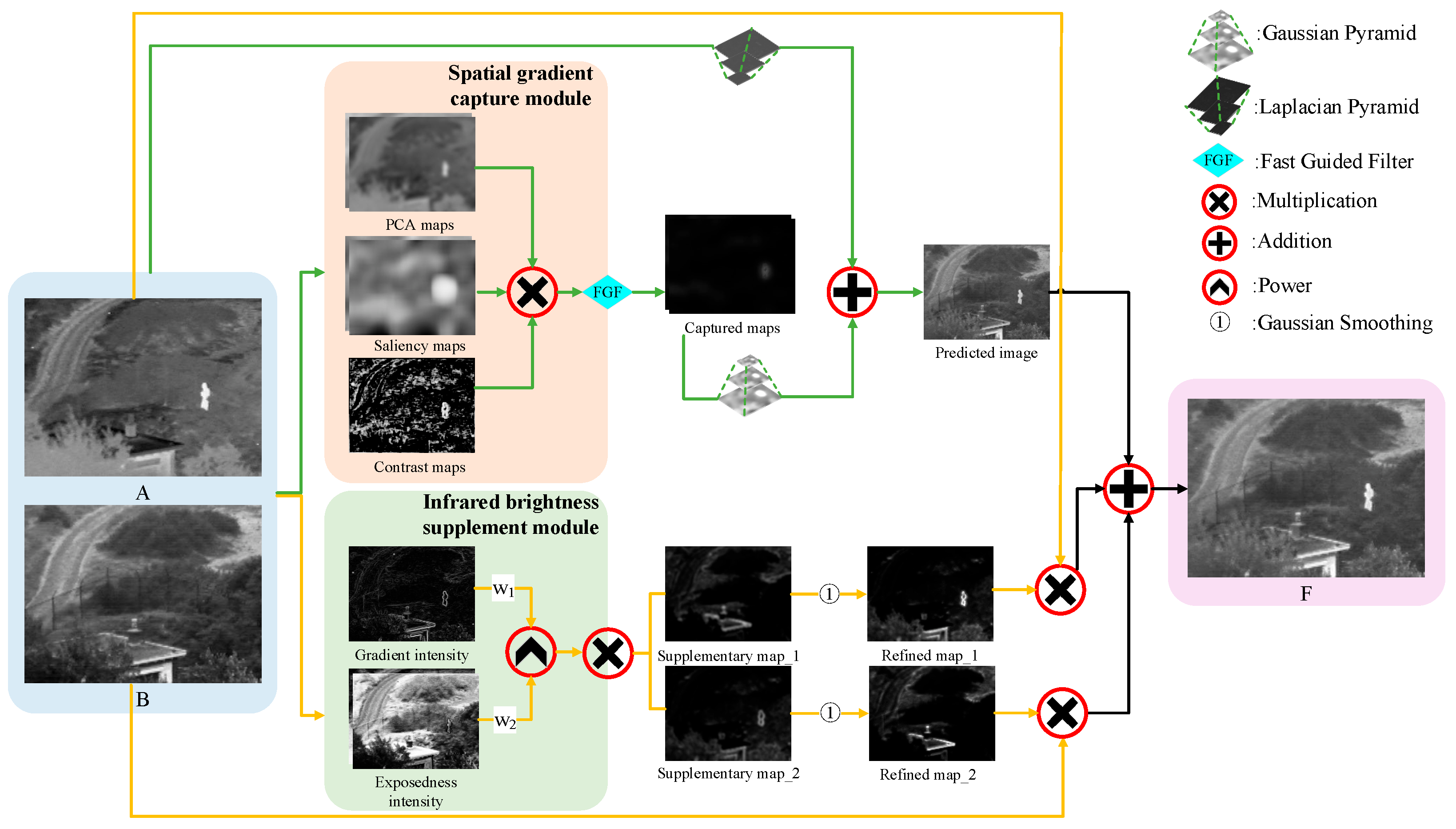
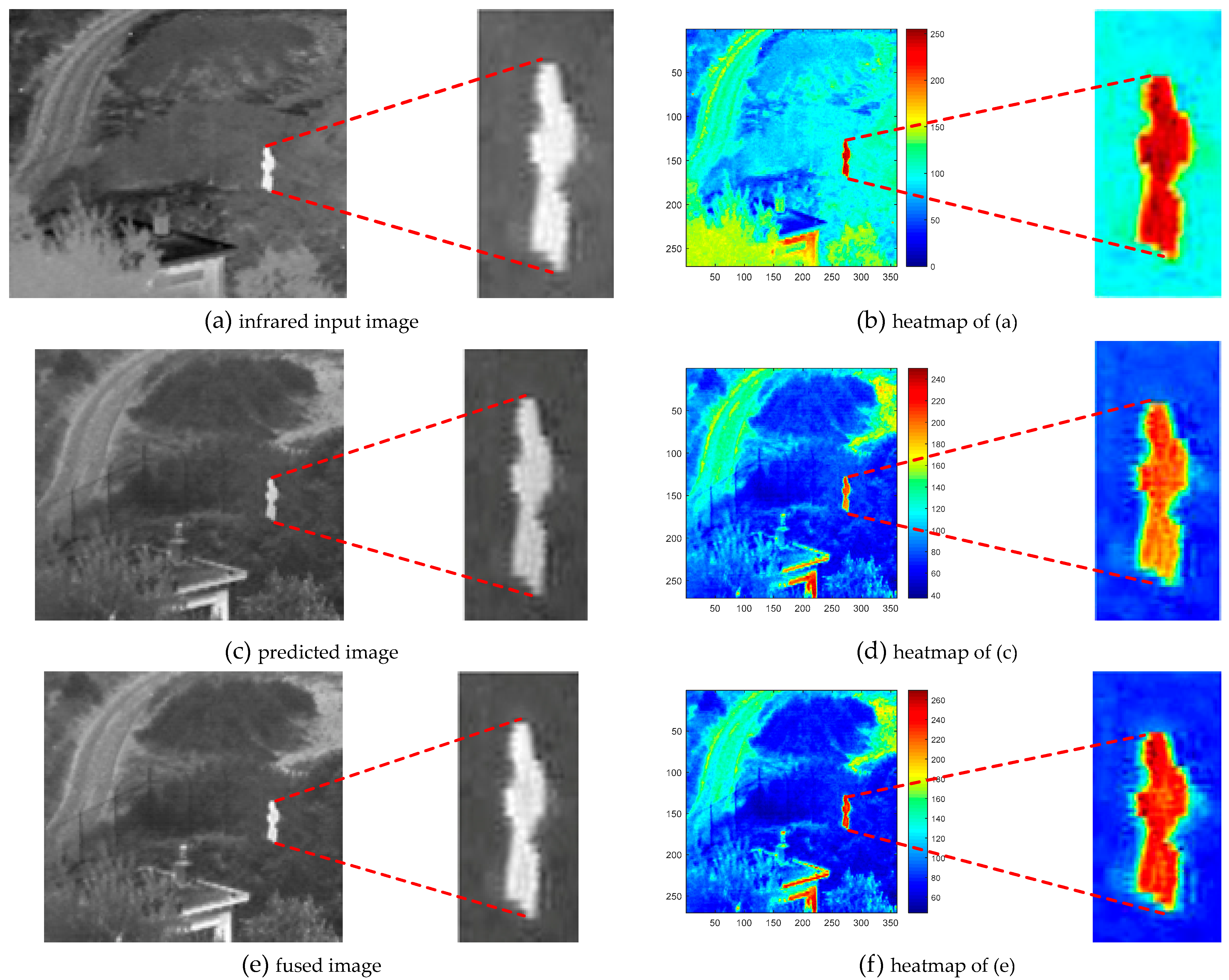
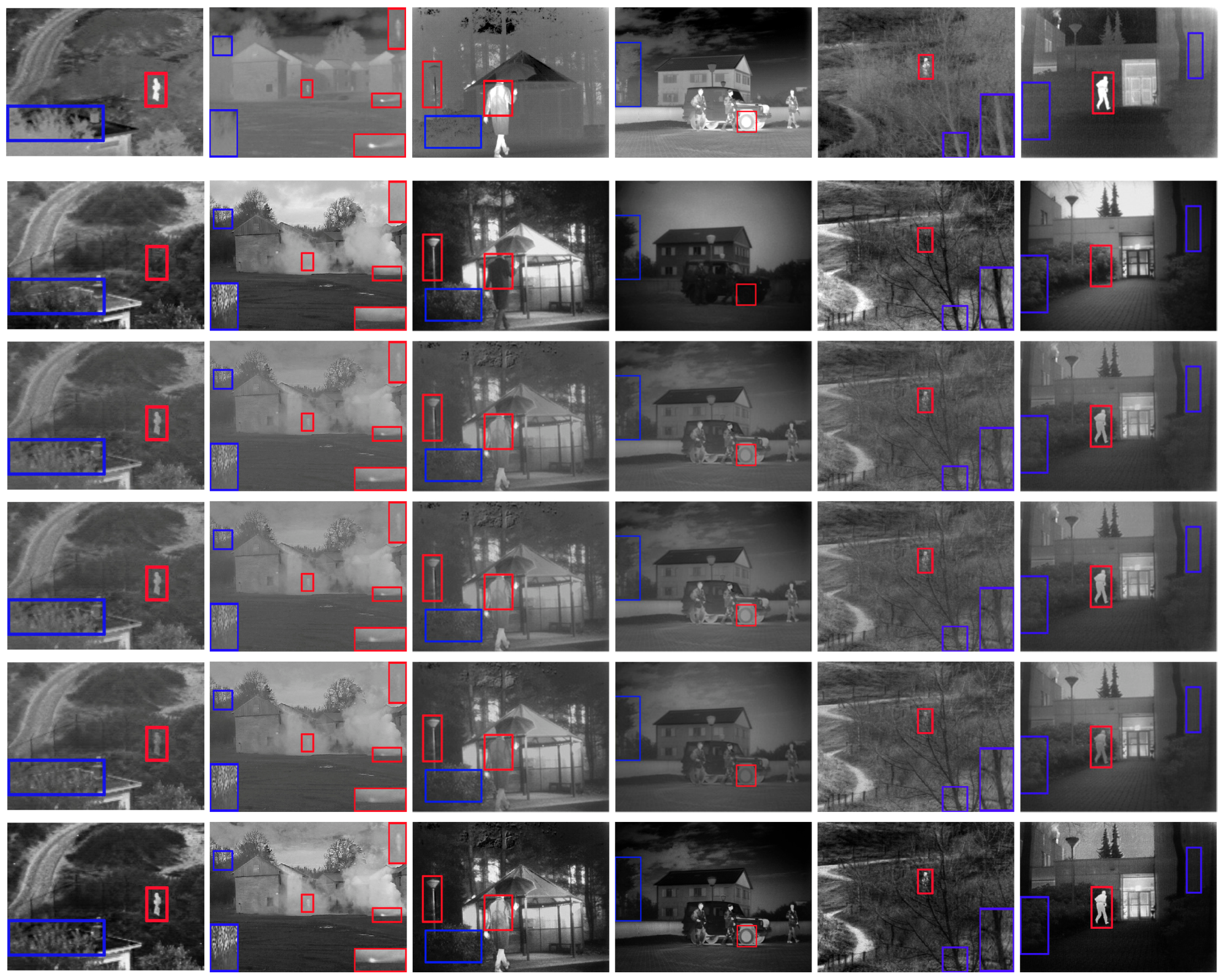
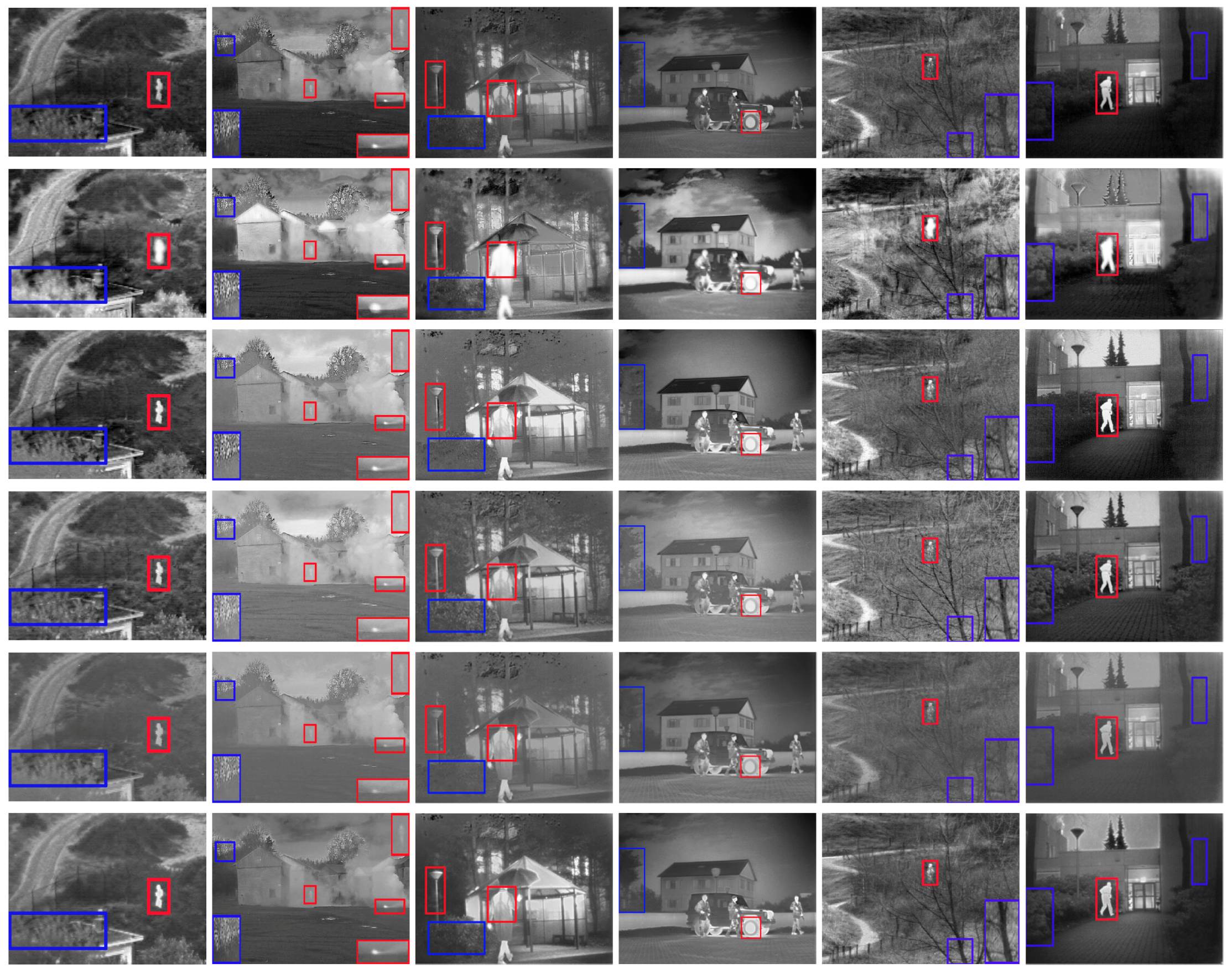
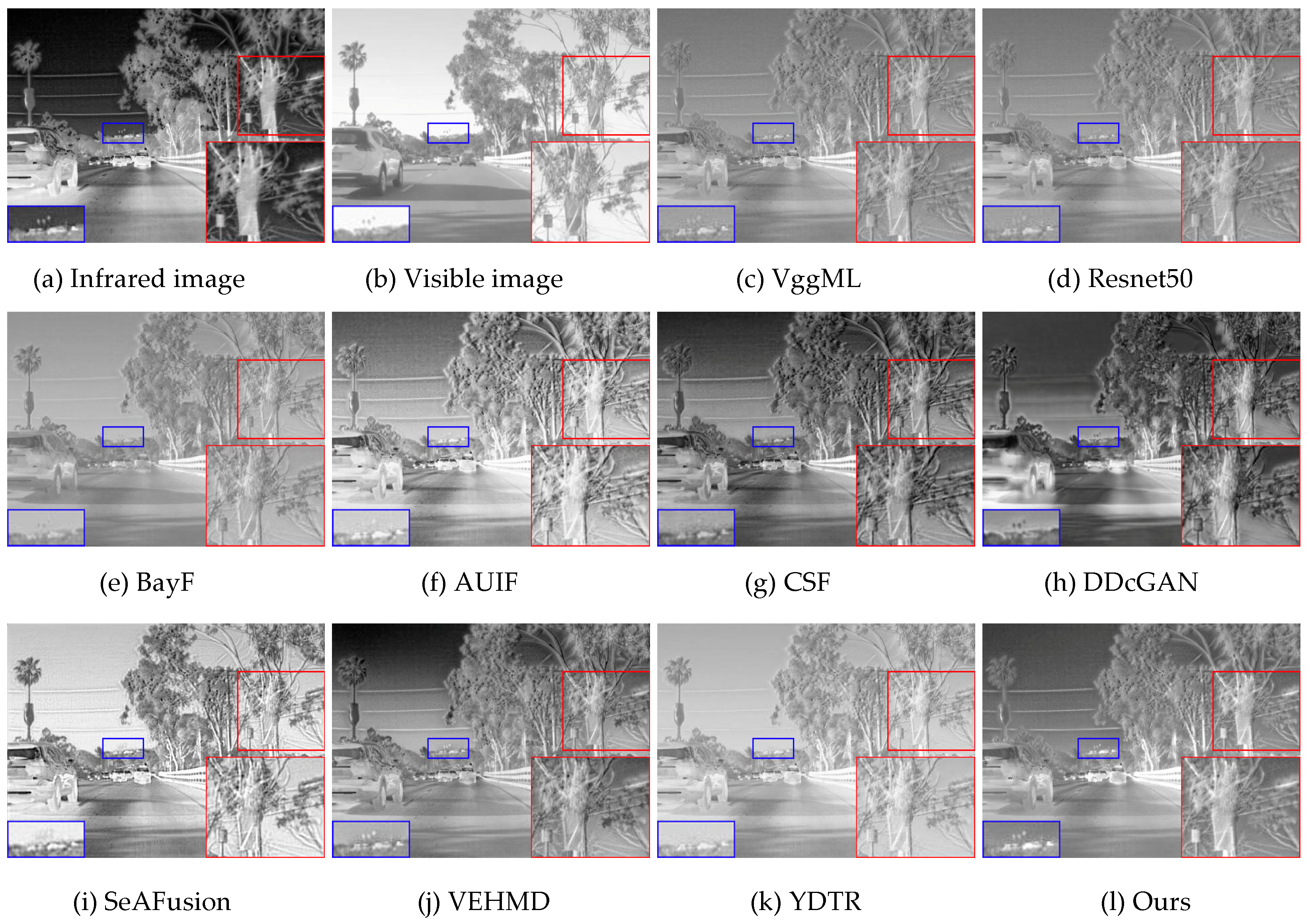
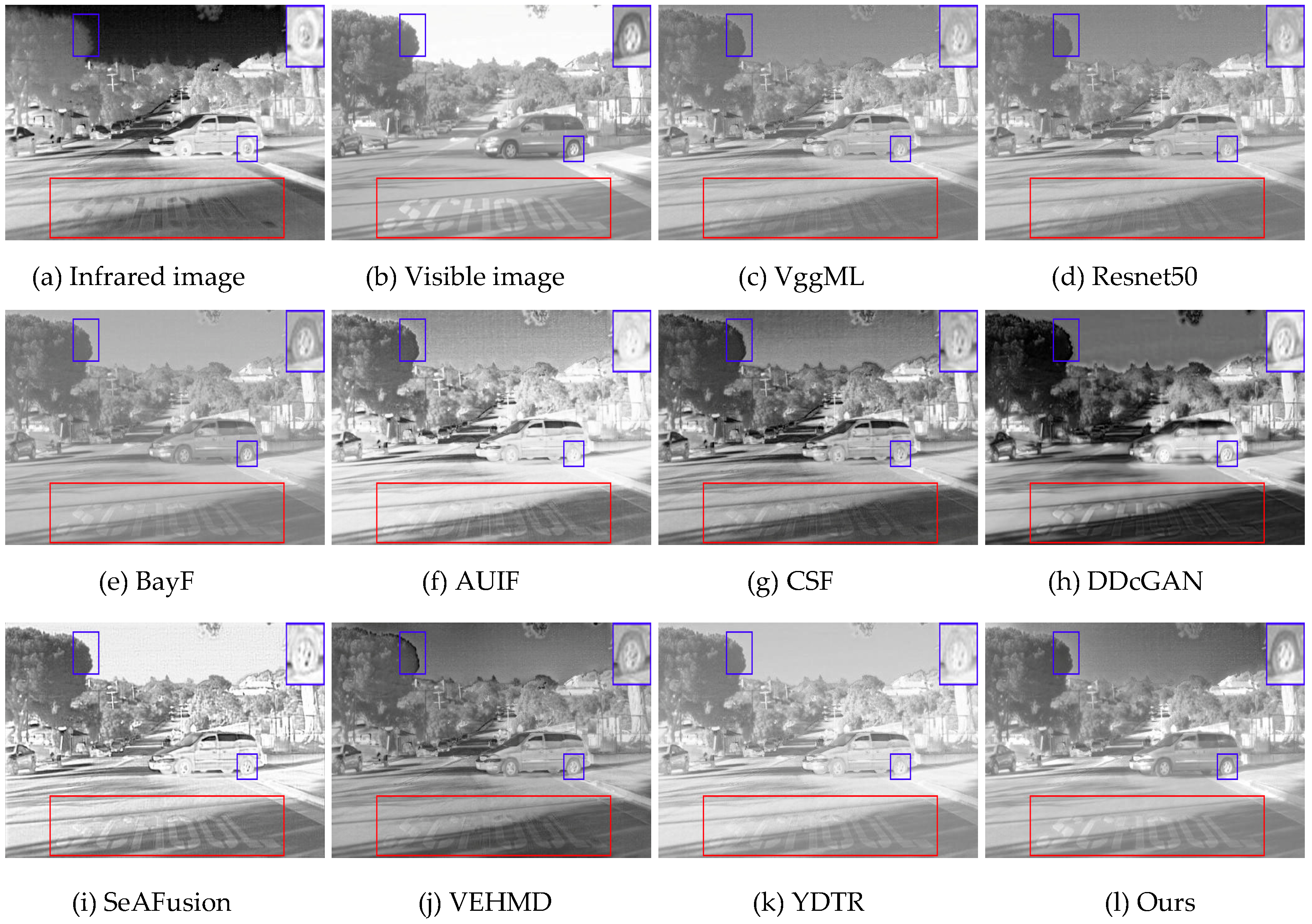

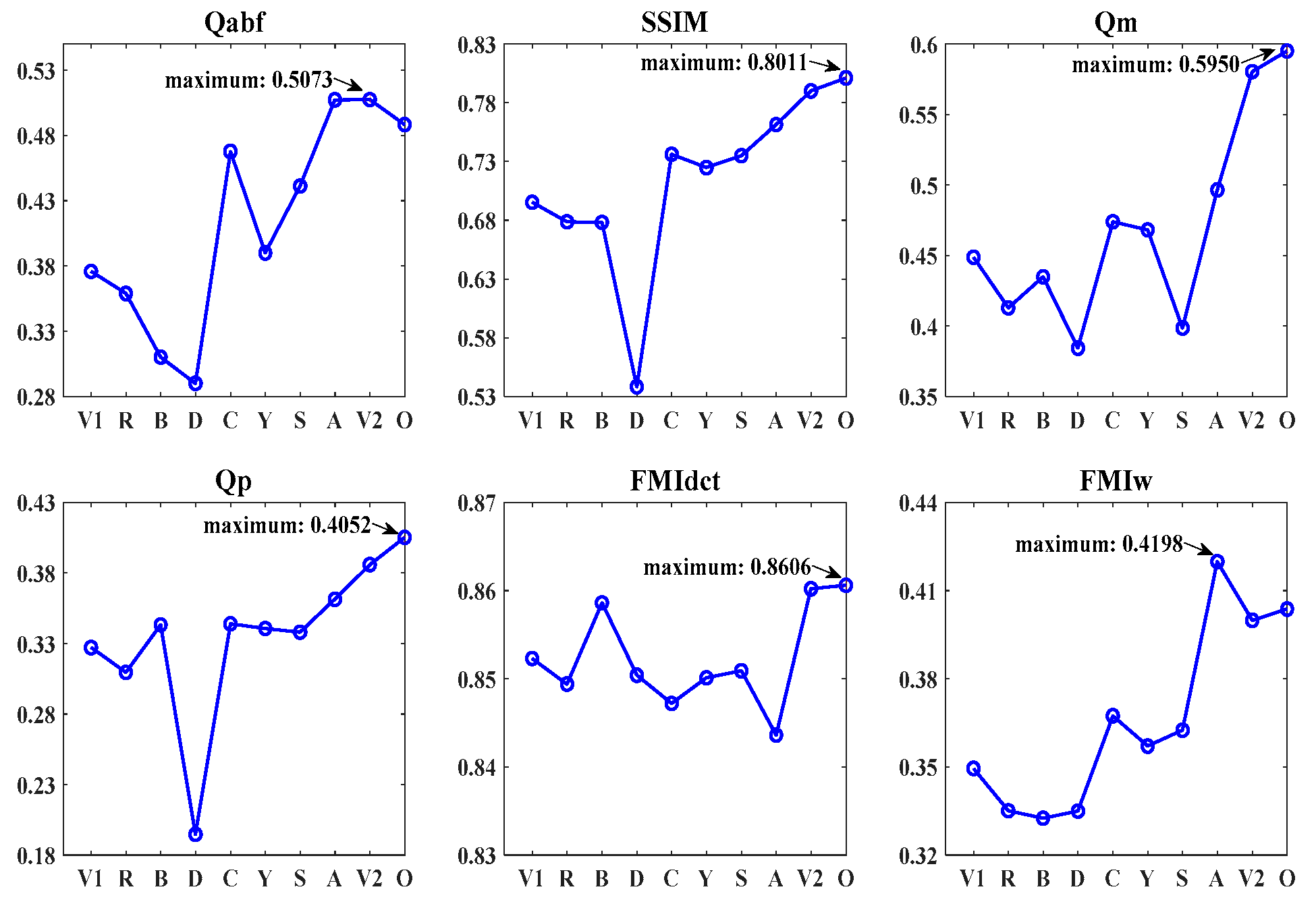

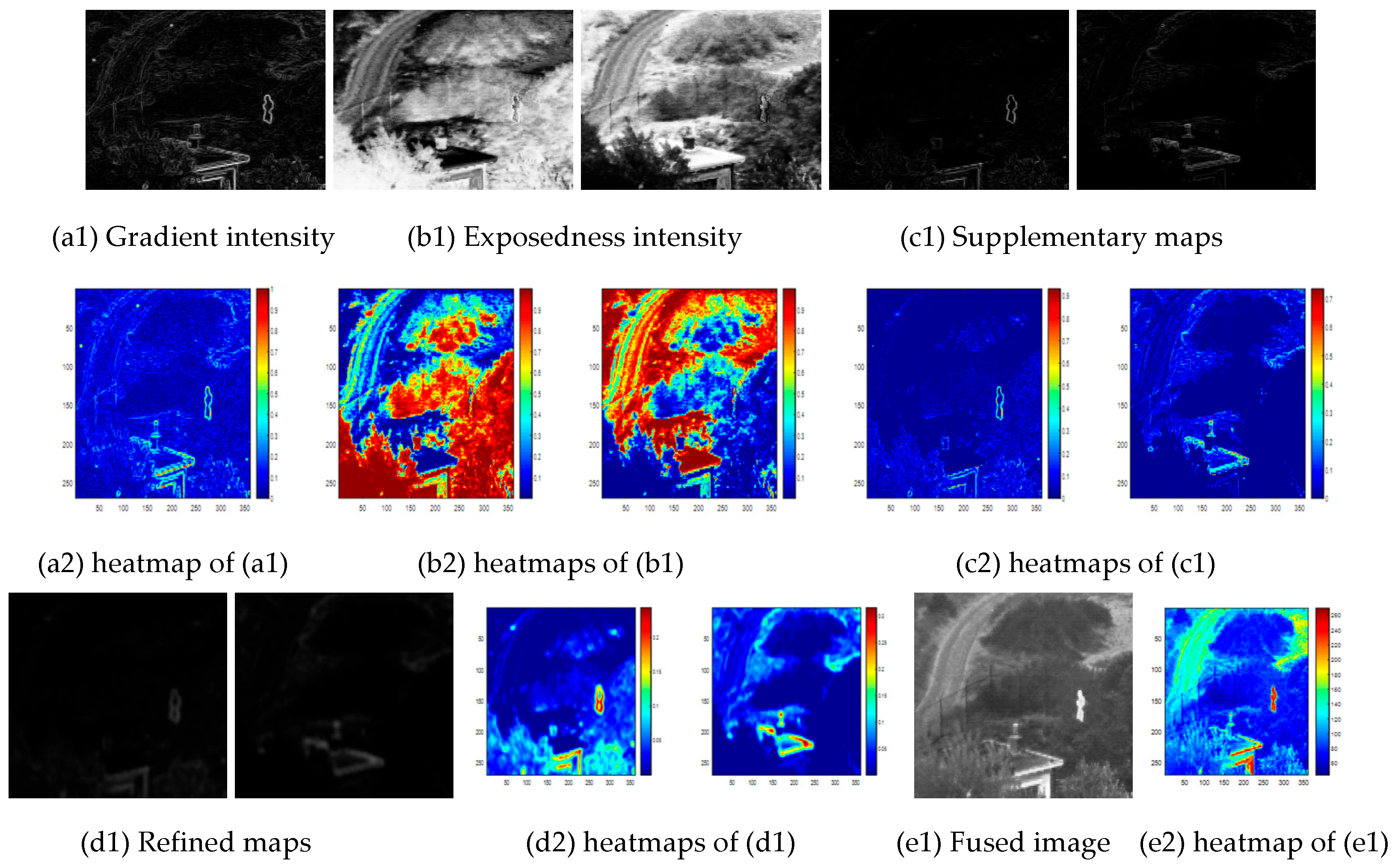
| Parameters | FGF | |||||
|---|---|---|---|---|---|---|
| Optimal value | 8 | 0.1 | 2 | 1.0 | 2.8 | 3 |
| Metrics | ||||
|---|---|---|---|---|
| Qabf | 0.4894 | 0.4816 | 0.4456 | 0.4091 |
| SSIM | 0.8349 | 0.8270 | 0.7854 | 0.7428 |
| Qm | 0.7102 | 0.6878 | 0.6246 | 0.5845 |
| Qp | 0.3974 | 0.3866 | 0.3361 | 0.2891 |
| FMIdct | 0.8924 | 0.8916 | 0.8870 | 0.8821 |
| FMIw | 0.4146 | 0.4098 | 0.3887 | 0.3713 |
| Metrics | ||||||
|---|---|---|---|---|---|---|
| Qabf | 0.4757 | 0.4710 | 0.4844 | 0.4766 | 0.4920 | 0.4774 |
| SSIM | 0.8270 | 0.8237 | 0.8323 | 0.8269 | 0.8363 | 0.8266 |
| Qm | 0.6922 | 0.6837 | 0.7049 | 0.6917 | 0.7092 | 0.6858 |
| Qp | 0.3877 | 0.3851 | 0.3939 | 0.3897 | 0.3994 | 0.3909 |
| FMIdct | 0.8922 | 0.8919 | 0.8924 | 0.8910 | 0.8927 | 0.8909 |
| FMIw | 0.4096 | 0.4085 | 0.4127 | 0.4115 | 0.4154 | 0.4119 |
| Metrics | Qabf | SSIM | Qm | Qp | FMIdct | FMIw | |
|---|---|---|---|---|---|---|---|
| 0.4897 | 0.8336 | 0.7080 | 0.3931 | 0.8922 | 0.4133 | ||
| 0.4908 | 0.8347 | 0.7090 | 0.3958 | 0.8923 | 0.4140 | ||
| 0.4912 | 0.8351 | 0.7096 | 0.3969 | 0.8925 | 0.4144 | ||
| 0.4916 | 0.8357 | 0.7095 | 0.3984 | 0.8926 | 0.4149 | ||
| 0.4906 | 0.8326 | 0.7059 | 0.3886 | 0.8885 | 0.4134 | ||
| 0.4919 | 0.8362 | 0.7093 | 0.3994 | 0.8926 | 0.4154 | ||
| 0.4920 | 0.8363 | 0.7085 | 0.3998 | 0.8926 | 0.4155 | ||
| 0.4921 | 0.8365 | 0.7086 | 0.4005 | 0.8926 | 0.4158 | ||
| 0.4920 | 0.8365 | 0.7088 | 0.4005 | 0.8926 | 0.4158 | ||
| Metrics | ||||
|---|---|---|---|---|
| Qabf | 0.4947 | 0.4879 | 0.4835 | 0.4806 |
| SSIM | 0.8381 | 0.8338 | 0.8310 | 0.8287 |
| Qm | 0.7106 | 0.7025 | 0.6947 | 0.6900 |
| Qp | 0.4011 | 0.3987 | 0.3967 | 0.3951 |
| FMIdct | 0.8927 | 0.8921 | 0.8921 | 0.8920 |
| FMIw | 0.4160 | 0.4152 | 0.4145 | 0.4138 |
| Methods | Average Running Time (unit: s) | |
|---|---|---|
| TNO Dataset | RoadScene Dataset | |
| VggML | 5.9308 | 3.5316 |
| Resnet50 | 3.7758 | 2.7426 |
| BayF | 1.1611 | 0.8939 |
| DDcGAN | 3.2797 | 1.3940 |
| YDTR | 2.1307 | 1.8370 |
| CSF | 14.8467 | 7.7464 |
| VEHMD | 78.2178 | 48.2212 |
| SeAFusion | 0.0033 | 0.0029 |
| AUIF | 12.4612 | 7.1988 |
| Ours | 7.6707 | 7.0148 |
Disclaimer/Publisher’s Note: The statements, opinions and data contained in all publications are solely those of the individual author(s) and contributor(s) and not of MDPI and/or the editor(s). MDPI and/or the editor(s) disclaim responsibility for any injury to people or property resulting from any ideas, methods, instructions or products referred to in the content. |
© 2023 by the authors. Licensee MDPI, Basel, Switzerland. This article is an open access article distributed under the terms and conditions of the Creative Commons Attribution (CC BY) license (https://creativecommons.org/licenses/by/4.0/).
Share and Cite
Zhang, Y.; Lee, H.J. Infrared and Visible Image Fusion via Feature-Oriented Dual-Module Complementary. Appl. Sci. 2023, 13, 2907. https://doi.org/10.3390/app13052907
Zhang Y, Lee HJ. Infrared and Visible Image Fusion via Feature-Oriented Dual-Module Complementary. Applied Sciences. 2023; 13(5):2907. https://doi.org/10.3390/app13052907
Chicago/Turabian StyleZhang, Yingmei, and Hyo Jong Lee. 2023. "Infrared and Visible Image Fusion via Feature-Oriented Dual-Module Complementary" Applied Sciences 13, no. 5: 2907. https://doi.org/10.3390/app13052907
APA StyleZhang, Y., & Lee, H. J. (2023). Infrared and Visible Image Fusion via Feature-Oriented Dual-Module Complementary. Applied Sciences, 13(5), 2907. https://doi.org/10.3390/app13052907






